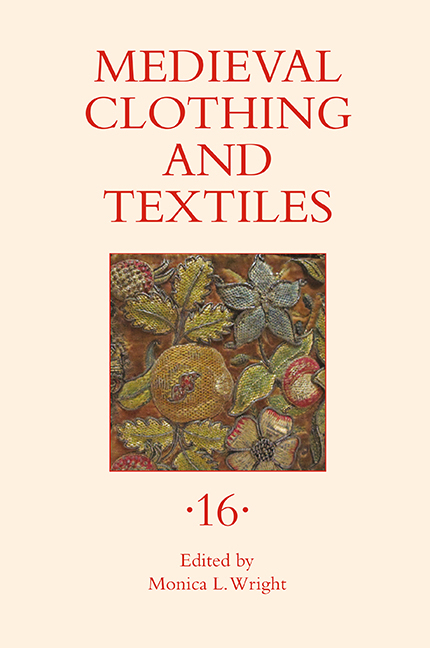Book contents
- Frontmatter
- Contents
- Illustrations
- Tables
- Contributors
- Preface
- 1 Anglo-Saxon Banners and Beowulf
- 2 The Use of Curved Templates in the Drawing of the Bayeux Tapestry
- 3 Construction and Reconstruction of the Past: The Medieval Nordic Textile Heritage of Hemp
- 4 Historicizing the Allegorical Eye: Reading Lady Mede
- 5 Sex, Lies, and Verdugados: Juana of Portugal and the Invention of Hoopskirts
- 6 Fashion and Material Culture in the Tabletop of the Seven Deadly Sins Attributed to Hieronymus Bosch
- 7 The Broderers’ Crown: The Examination and Reconstruction of a Sixteenth-Century City of London Livery Company Election Garland
- Appendix 7.1 Surviving Sixteenth-and Seventeenth-Century Embroidered Crowns of the City of London Livery Companies
- Recent Books of Interest
- Author Index, Volumes 1–15
7 - The Broderers’ Crown: The Examination and Reconstruction of a Sixteenth-Century City of London Livery Company Election Garland
Published online by Cambridge University Press: 27 March 2021
- Frontmatter
- Contents
- Illustrations
- Tables
- Contributors
- Preface
- 1 Anglo-Saxon Banners and Beowulf
- 2 The Use of Curved Templates in the Drawing of the Bayeux Tapestry
- 3 Construction and Reconstruction of the Past: The Medieval Nordic Textile Heritage of Hemp
- 4 Historicizing the Allegorical Eye: Reading Lady Mede
- 5 Sex, Lies, and Verdugados: Juana of Portugal and the Invention of Hoopskirts
- 6 Fashion and Material Culture in the Tabletop of the Seven Deadly Sins Attributed to Hieronymus Bosch
- 7 The Broderers’ Crown: The Examination and Reconstruction of a Sixteenth-Century City of London Livery Company Election Garland
- Appendix 7.1 Surviving Sixteenth-and Seventeenth-Century Embroidered Crowns of the City of London Livery Companies
- Recent Books of Interest
- Author Index, Volumes 1–15
Summary
It has been a longstanding custom for many London livery companies to inaugurate the newly chosen master and wardens with a crown or garland during an election ceremony. The tradition may have derived from the Puy of Arras, an extravagant medieval festival of community and music dedicated to the Virgin, originating in the textile manufacturing city in northern France. A fraternity of the Puy was established in London and the membership was diverse, admitting merchants trading in a variety of commodities. The first set of statutes was in existence as early as 1280, and a revised set dates from the early fourteenth century. The statutes are transcribed in the Liber Custumarum, a collection of medieval manuscripts pertaining to the laws and history of London preserved in the London Guildhall and compiled by city chamberlain Andrew Horn in the 1320s. Written in French, they describe the election process and official ceremony for crowning the selected prince with the coroune dou Puy in detail. The popularity of the London Puy was short-lived, however, and appears to have declined with the adversities brought on by economic and social hardships in the early decades of the fourteenth century.
In 1345, the first documented statutes for a London guild were recorded by the fraternity of the Peppers in Soper Lane. Similar to those of the Puy but wholly unrelated, these ordinances were also written in French and included a schedule of events defining the election procedure and investment ceremony of the two wardens (deux gardiens) who wore crowns (chapletz). A description of the chapletz is not provided in these first ordinances but, in 1405, the accounts of the Grocers’ Company show the chaplets are included with an entry for bread, wine, cheese, apples, and beer, so we may logically assume that they were made of an organic substance, such as rosemary or perhaps roses. The next recorded entry is in 1408 when, having been struck from an entry including bread, wine, and apples, they appear as the single item on the next line at a cost of 20d. for three.
A review of documentary and material evidence of the city livery company crown from the fifteenth to the early seventeenth centuries, focusing on the materials and techniques used, illustrates how the crown developed from a transitory wreath of fresh leaves or herbs to a more permanent textile object.
- Type
- Chapter
- Information
- Medieval Clothing and Textiles 16 , pp. 163 - 190Publisher: Boydell & BrewerPrint publication year: 2020

